The x86 Power Myth Busted: In-Depth Clover Trail Power Analysis
by Anand Lal Shimpi on December 24, 2012 5:00 PM ESTSunSpider 0.9.1
Now the fun stuff. Doing power profiles of our standard benchmarks gives us good insight into how well each vendor was able to balance peak performance and average power. In general it's ok to burn more power for a short amount of time as long as it means you'll get to sleep quicker. This was one of the fundamentals of the first transition to mobile from the early 2000s.
We already know that Intel completes SunSpider quicker thanks to its improved memory subsystem over the Cortex A9, but it also does so with much better average power (3.70W vs. 4.77W for this chart). A big part of the average power savings comes courtesy of what happens at the very tail end of this graph where the W510 is able to race to sleep quicker, and thus saves a good deal of power.
| JavaScript Performance | |||||||
| Time in ms (Lower is Better) | Kraken | SunSpider | RIA Bench Focus | ||||
| Acer W510 (Atom Z2760 1.8GHz) | 33220.9ms | 730.8ms | 3959ms | ||||
| Microsoft Surface (Tegra 3 1.3GHz) | 49595.5ms | 981.1ms | 5880ms | ||||
| Samsung ATIV Smart PC (Atom Z2760 1.8GHz) | 33406.0ms | 721.3ms | 3752ms | ||||
| Apple iPad 4 (A6X) | 19086.9ms | 834.7ms | - | ||||
| Google Nexus 10 (Exynos 5 Dual) | 11146.0ms | 1384.1ms | - | ||||
I also used SunSpider as an opportunity to validate the results from Intel's tablets with my own review samples. To generate this chart I measured power, every second, at the wall with both devices plugged in and with a fully charged battery. The resulting power consumption numbers include the efficiency loss at the AC adapter but the general curve shoud mimic the results above:
Note that the results do generally line up, although measuring at the battery gives more accurate results for the device and using the NI DAQ I was able to get better granularity on the power measurements.
Looking at CPU level power consumption we see a very even match between Atom and Tegra 3. Intel's advantage really comes from being able to complete the workload quicker (0.52W compared to 0.72W on average).
Once again we see a pretty significant difference in power consumption on the GPU rail between these two platforms.
Kraken
Mozilla's Kraken benchmark is a new addition to our js performance suite, and it's a beast. The test runs for much longer than SunSpider, but largely tells a similar story:
RIABench
RIABench's Focus Tests are on the other end of the spectrum, and take a matter of seconds to complete. What we get in turn is a more granular look at power consumption:




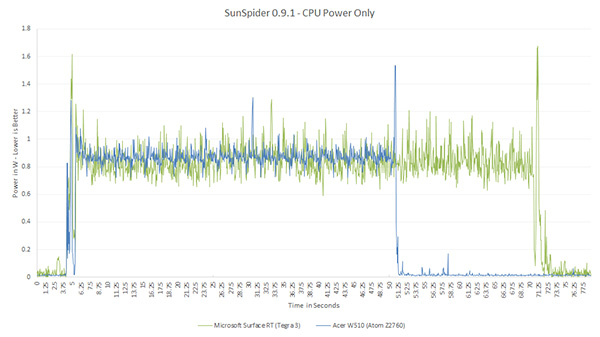

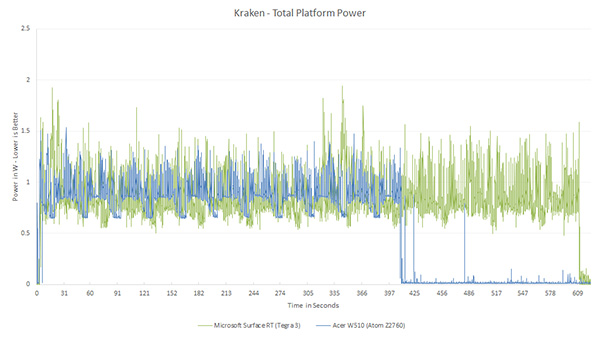
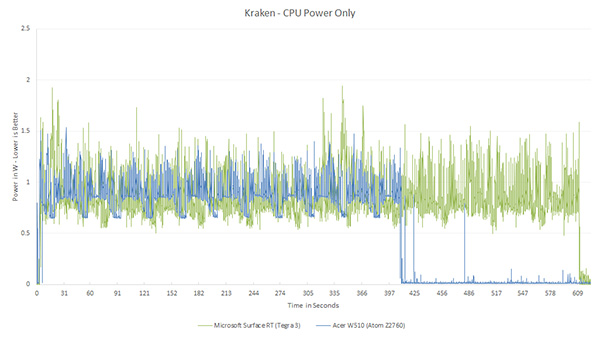

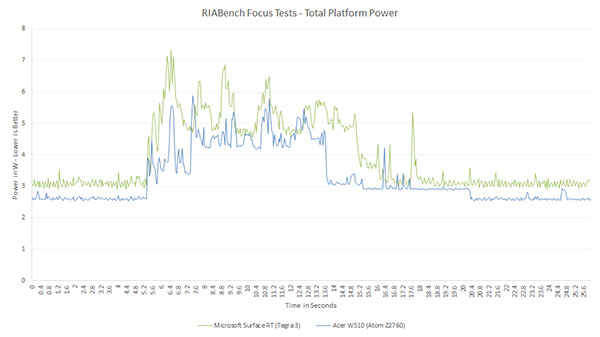
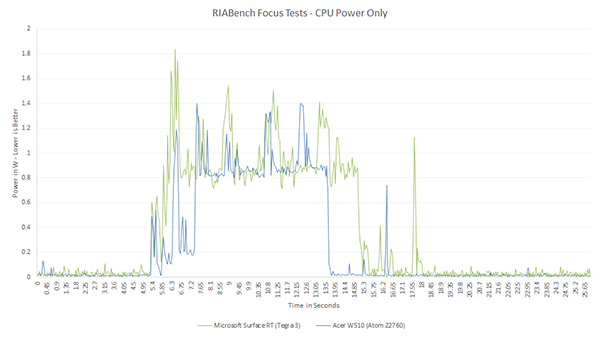
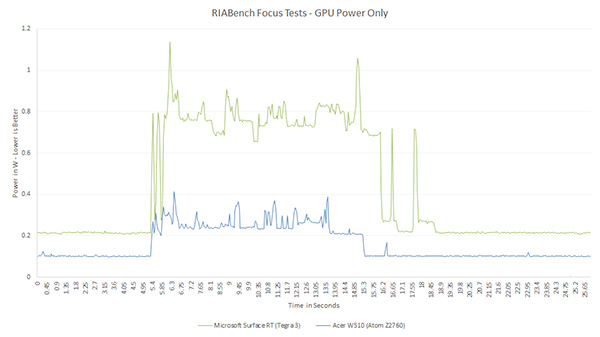








163 Comments
View All Comments
flashbacck - Monday, December 24, 2012 - link
"... Intel adopted a "no more surprises" policy... "What the F does that even mean? Don't build shitty products? Only upper management could come up with this genius policy.
magreen - Monday, December 24, 2012 - link
Now we had a chance to hear your comment, and boy you're just a straight shooter with upper management written all over you.lmcd - Tuesday, December 25, 2012 - link
Intel's philosophy pays off in Windows, for sure.Now, they've got Qualcomm to beat. That's going to take a bit more doing than beating a year-old chip.
lunarx3dfx - Tuesday, December 25, 2012 - link
I think several people misunderstood the purpose of this article. The purpose was to make the point clear that x86 could be performance/watt comparable to arm. Yes, clover trail is only beating a Tegra, but considering where Intel was only a year ago this looks promising. I don't see Anand being biased here, I see him making a point about power efficiency.coolhund - Tuesday, December 25, 2012 - link
Really? The x86 processor was an out of order architecture?Nope. Apples and oranges that way.
Gigaplex - Tuesday, December 25, 2012 - link
So what if it's not out of order? That's got nothing to do with the ISA. ARM could build an out of order chip if they wanted.coolhund - Tuesday, December 25, 2012 - link
The A9 is out of order, so is the A15. Thats not what I meant.yyrkoon - Tuesday, December 25, 2012 - link
The myth where ARM did perform more power efficiently than x86 before Intel starting caring ?Simple matter of the fact is that A9 does not encompass what ARM *is* (Neither does Tegra 3 for that matter ), and there are far more ARM based processors out in the world than Intel. This will likely continue into the foreseeable future. Simply because "ARM" is not locked into a specific market in the compute space.
Personally I am all for seeing Intel improve the power efficiency of their products. However, my own opinion is that Intel should either ditch atom, and improve their server, desktop, and mobile processors. And / or create another processor(s) that can decide on what it really wants to be. e.g. embedded application processor, or not.
One thing is for sure. Intel has their work cut out for them if they want to compete with ARM in the embedded market. One thing worth mentioning that is kind of ironic. x86 is supposed to be the general purpose type processor, yet the usage of various ARM based processor seem to be more diverse.
wsw1982 - Tuesday, December 25, 2012 - link
The atom want to be used in the smartphone and cheap tablet market, I think, at least now, Intel is quite clear about it. And it's very competitive now with the ARM solutions, so I don't see the reason why intel should abandon it along with the smartphone market. The core has been actually improved a lot and, to me, always the main focus of Intel.beginner99 - Tuesday, December 25, 2012 - link
... to compare to tegra 3. I think most would agree that comparing to dual-core A15 the outcome would be vastly different. But then I think we should not get fooled by Intel. As was mentioned this is still only a derivative of the original Atom on a smaller node. For Intel this is IMHO just a current placeholder. The real deal will come with the complete new uArch for Atom and if they manage to "pull off a Core 2" again (which I believe) it won't look pretty for Team ARM.